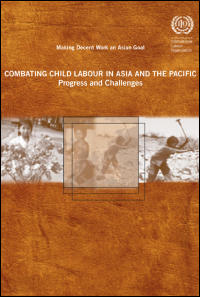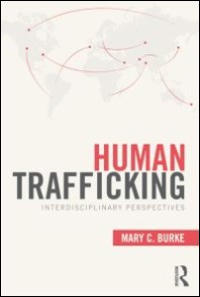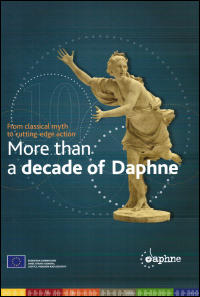Publications on violence against children and women
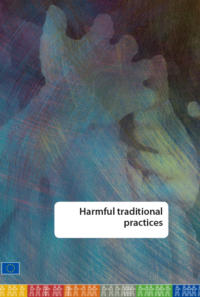
This is the third in a series of eight booklets looking at different forms of violence against children, young people and women in Europe. It gives an overview of the problem – in this case harmful traditional practices – and presents some of the responses tested by organizations across the EU, supported by the European Commission’s Daphne Programme.
Download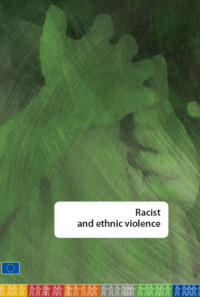
This is the fourth in a series of eight booklets looking at different forms of violence against children, young people and women in Europe. It gives an overview of the problem – in this case violence on racist and ethnic grounds – and presents some of the responses tested by organizations across the EU, supported by the European Commission’s Daphne Programme.
Download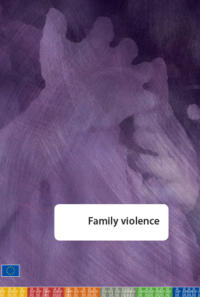
This is the fifth in a series of eight booklets looking at different forms of violence against children, young people and women in Europe. It gives an overview of the problem – in this case violence that occurs within the broadly defined ‘family’ – and presents some of the responses tested by organizations across the EU, supported by the European Commission’s Daphne Programme.
Download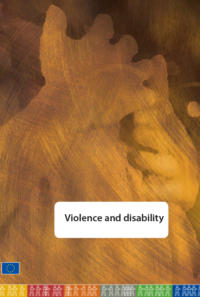
This is the sixth in a series of eight booklets looking at different forms of violence against children, young people and women in Europe. It gives an overview of the problem – in this case the links between violence and disability – and presents some of the responses tested by organizations across the EU, supported by the European Commission’s Daphne Programme.
Download
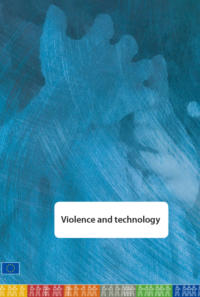
This is the seventh in a series of eight booklets looking at different forms of violence against children, young people and women in Europe. It gives an overview of the problem – in this case violence and technology – and presents some of the responses tested by organizations across the EU, supported by the European Commission’s Daphne Programme. It was co-authored with Pamela Portin.
Download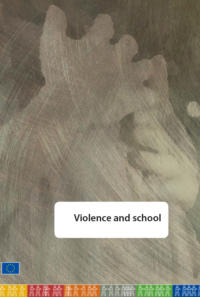
This is the eighth in a series of eight booklets looking at different forms of violence against children, young people and women in Europe. It gives an overview of the problem – in this case violence and school – and presents some of the responses tested by organizations across the EU, supported by the European Commission’s Daphne Programme.
Download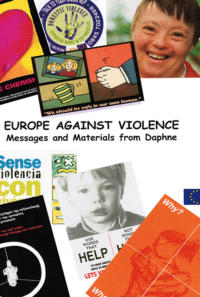
Between 1997 and 2002, some 40-50 projects were funded by the European Commission’s Daphne Programme every year. A number of projects included campaign/awareness-raising materials carrying different messages relating to the combat against violence. Almost all of these were used in more than one EU country, but none of them had been used right across Europe. In 2002, therefore, the EC decided to begin bringing together some of these materials into a modest ‘library’. This is the booklet that explains the materials, provides lessons learned and gives references to finding the materials on the EU website.
Download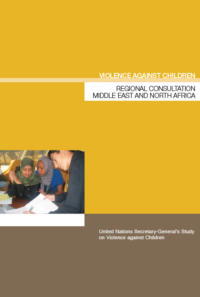
This is one of a series of reports on the regional consultations organized to contribute to the United Nations Secretary-General’s Study on Violence against Children in 2007. Preparatory work painted a clear picture not only of what already exists in the areas of protection of children, prevention of violence and support to victims, but also where gaps and challenges remain. In each region, the participants in the consultation – including children and young people themselves – developed a statement of intent and a practical indication of actions that need to be taken. In some regions, countries also developed specific national action plans that they undertook to implement as a matter of priority.
Download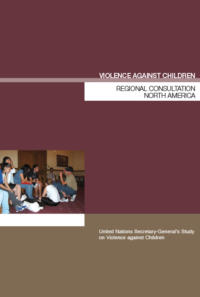
This is one of a series of reports on the regional consultations organized to contribute to the United Nations Secretary-General’s Study on Violence against Children in 2007. Preparatory work painted a clear picture not only of what already exists in the areas of protection of children, prevention of violence and support to victims, but also where gaps and challenges remain. In each region, the participants in the consultation – including children and young people themselves – developed a statement of intent and a practical indication of actions that need to be taken. In some regions, countries also developed specific national action plans that they undertook to implement as a matter of priority.
Download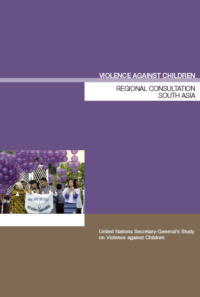
This is one of a series of reports on the regional consultations organized to contribute to the United Nations Secretary-General’s Study on Violence against Children in 2007. Preparatory work painted a clear picture not only of what already exists in the areas of protection of children, prevention of violence and support to victims, but also where gaps and challenges remain. In each region, the participants in the consultation – including children and young people themselves – developed a statement of intent and a practical indication of actions that need to be taken. In some regions, countries also developed specific national action plans that they undertook to implement as a matter of priority.
Download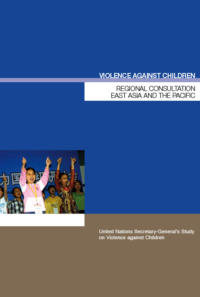
This is one of a series of reports on the regional consultations organized to contribute to the United Nations Secretary-General’s Study on Violence against Children in 2007. Preparatory work painted a clear picture not only of what already exists in the areas of protection of children, prevention of violence and support to victims, but also where gaps and challenges remain. In each region, the participants in the consultation – including children and young people themselves – developed a statement of intent and a practical indication of actions that need to be taken. In some regions, countries also developed specific national action plans that they undertook to implement as a matter of priority.
Download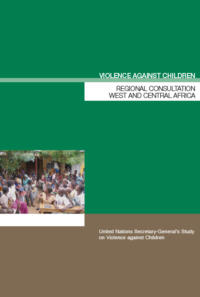
This is one of a series of reports on the regional consultations organized to contribute to the United Nations Secretary-General’s Study on Violence against Children in 2007. Preparatory work painted a clear picture not only of what already exists in the areas of protection of children, prevention of violence and support to victims, but also where gaps and challenges remain. In each region, the participants in the consultation – including children and young people themselves – developed a statement of intent and a practical indication of actions that need to be taken. In some regions, countries also developed specific national action plans that they undertook to implement as a matter of priority.
Download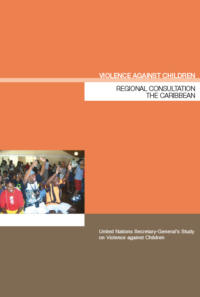
This is one of a series of reports on the regional consultations organized to contribute to the United Nations Secretary-General’s Study on Violence against Children in 2007. Preparatory work painted a clear picture not only of what already exists in the areas of protection of children, prevention of violence and support to victims, but also where gaps and challenges remain. In each region, the participants in the consultation – including children and young people themselves – developed a statement of intent and a practical indication of actions that need to be taken. In some regions, countries also developed specific national action plans that they undertook to implement as a matter of priority.
Download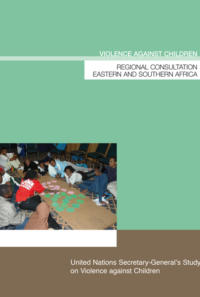
This is one of a series of reports on the regional consultations organized to contribute to the United Nations Secretary-General’s Study on Violence against Children in 2007. Preparatory work painted a clear picture not only of what already exists in the areas of protection of children, prevention of violence and support to victims, but also where gaps and challenges remain. In each region, the participants in the consultation – including children and young people themselves – developed a statement of intent and a practical indication of actions that need to be taken. In some regions, countries also developed specific national action plans that they undertook to implement as a matter of priority.
Download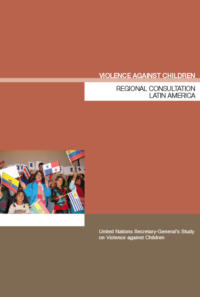
This is one of a series of reports on the regional consultations organized to contribute to the United Nations Secretary-General’s Study on Violence against Children in 2007. Preparatory work painted a clear picture not only of what already exists in the areas of protection of children, prevention of violence and support to victims, but also where gaps and challenges remain. In each region, the participants in the consultation – including children and young people themselves – developed a statement of intent and a practical indication of actions that need to be taken. In some regions, countries also developed specific national action plans that they undertook to implement as a matter of priority.
Download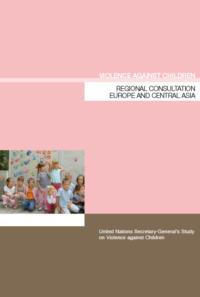
This is one of a series of reports on the regional consultations organized to contribute to the United Nations Secretary-General’s Study on Violence against Children in 2007. Preparatory work painted a clear picture not only of what already exists in the areas of protection of children, prevention of violence and support to victims, but also where gaps and challenges remain. In each region, the participants in the consultation – including children and young people themselves – developed a statement of intent and a practical indication of actions that need to be taken. In some regions, countries also developed specific national action plans that they undertook to implement as a matter of priority.
Download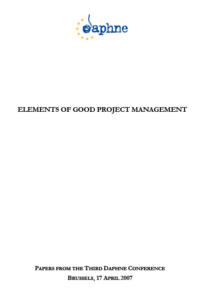
For three years between 2004 and 2006, the European Commission’s Daphne Programme to combat violence against children, young people and women, brought together the coordinators and project partners of the Daphne projects funded to give them technical, administrative and practical information and instructions for the management of their projects. Since its creation in 1997, the Daphne Programme has achieved a very good reputation in terms of its results and the impact of these results on children, young people and women in Europe. Sharing the lessons and enhancing the skills of the project organizations contributed greatly to this.
This is the report of the 2006 conference.
Download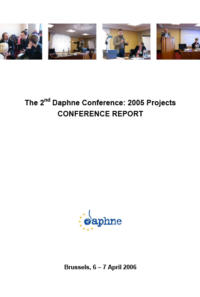
For three years between 2004 and 2006, the European Commission’s Daphne Programme to combat violence against children, young people and women, brought together the coordinators and project partners of the Daphne projects funded to give them technical, administrative and practical information and instructions for the management of their projects. Since its creation in 1997, the Daphne Programme has achieved a very good reputation in terms of its results and the impact of these results on children, young people and women in Europe. Sharing the lessons and enhancing the skills of the project organizations contributed greatly to this.
This is the report of the 2005 conference.
Download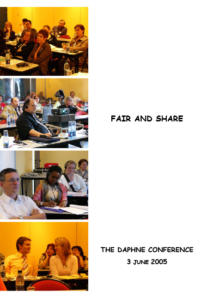
For three years between 2004 and 2006, the European Commission’s Daphne Programme to combat violence against children, young people and women, brought together the coordinators and project partners of the Daphne projects funded to give them technical, administrative and practical information and instructions for the management of their projects. Since its creation in 1997, the Daphne Programme has achieved a very good reputation in terms of its results and the impact of these results on children, young people and women in Europe. Sharing the lessons and enhancing the skills of the project organizations contributed greatly to this.
This is the report of the 2004 conference.
Download

